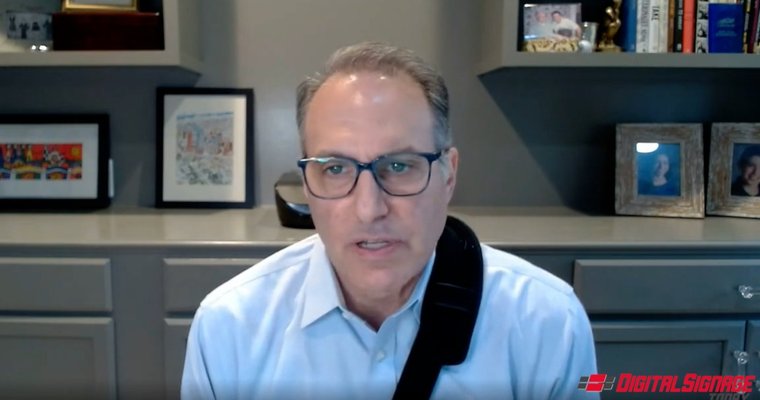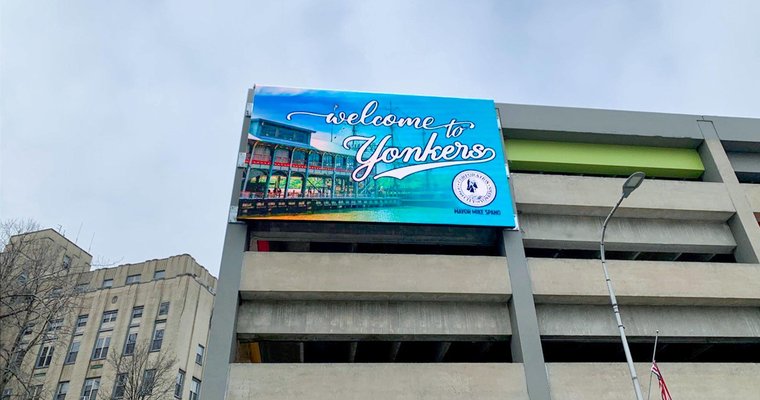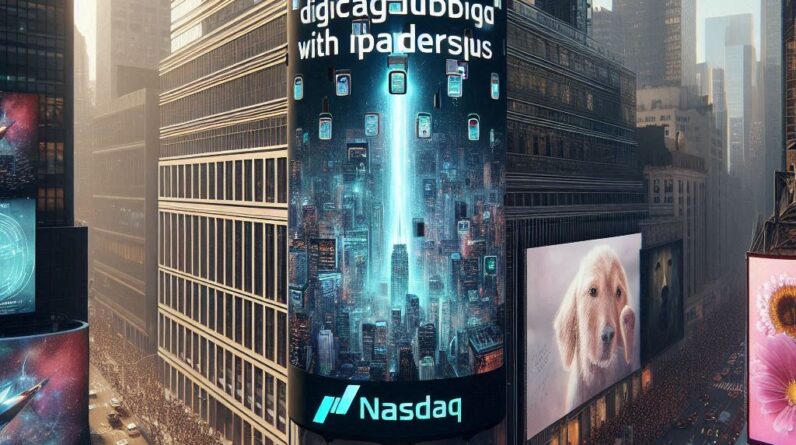
[ad_1]
Mike Slovin, general manager of Smart Solutions at Comcast, joined Digital Signage Today editor Daniel Brown via video link to share insights into smart cities and related movements, along with designing solutions for businesses and communities.
 Mike Slovin joined Digital Signage Today editor Daniel Brown via video link for an exclusive interview. Image credit: Daniel Brown/Digital Signage Today.
Mike Slovin joined Digital Signage Today editor Daniel Brown via video link for an exclusive interview. Image credit: Daniel Brown/Digital Signage Today.
 |
Mike Slovin is general manager of Smart Solutions at Comcast. Image provided by Finn Partners. |
Besides AI, it’s hard to think of a more overused term than “smart” — from smart cities and smart grids to smart signs and smart displays.
To get a feel for the growing “smart movement,” Digital Signage Today turned to Mike Slovin, general manager of Smart Solutions at Comcast, for a full overview of all the ways technologists are seeking to make the modern city (and world) a whole lot smarter — and maybe make things a bit more sustainable in the process.
Slovin shared insights into the art and science of designing solutions for businesses and communities, with a strong focus on digital signage and marketing elements along with their holistic connection to the industry’s efforts to tie people and systems together in more efficient ways.
From smart campuses to AI-powered digital signage networks and crime prevention tools, Slovin provided powerful insights into a relatively new field, ending the interview with an appeal to anyone in the audience, from individuals to companies, who has a good solution or idea to reach out and help with this rapidly growing effort.
Slovin’s special passions and expertise include bringing broadband to underserved communities, with an aim to bringing opportunities to previously disadvantaged individuals and businesses — especially, Slovin notes, K-12 students who need Internet access now more than ever to keep up with their peers in education.
Interview edited for clarity and length. Full transcript available below.
Interview Transcript
Mike Slovin: So, my name is Mike Slovin. I’m the general manager for smart solutions at Comcast. And really, we’re a relatively new organization. And we were created really to help businesses operate more efficiently and effectively. That’s really our role. And we do that by a couple of things. One is we bring together the best of Comcast technology — so, our conductivity and other services — along with creating an ecosystem of the smart partners that we’ll talk more about, I’m sure later, we create this ecosystem for customers to leverage to really solve business and community needs.
Daniel Brown:And it’s funny because everything’s becoming so interconnected. And of course, now we’re just going through this AI wave as well. But something I keep hearing more and more at industry events, and from interviews and conversations: people keep talking about Internet of Things, IoT, metaverse. I’ve heard people talk about the Smart Cities as a category. And I’m totally new to that. I know next to nothing. And I’m curious if you can kind of give us what’s the definition of smart cities that — does that tie into smart homes? And for digital signage, for our folks, does that tie into our display devices?
Slovin: Yes, it’s interesting, I think the category of ‘smart,’ in itself, is evolving, right? It’s a 100 billion dollar market (plus) in the US, fast-growing. So, Comcast really defines smart as a broad, smart communities category. So that could involve smart cities, single family communities, apartment communities, college campuses, etc. So similar technologies reach with maybe slightly different use cases. And really, I think we would define broadly a smart community as, really as a community that uses technology and data analytics to enhance efficiencies to reduce costs or improve the quality of life for residents or businesses. I think that’s how we’d probably look at it in the broadest sense.
Brown: So, it sounds like this is kind of almost a nascent or a new discipline, if you will. But that’d be fair, like the last few years?
Slovin: I think it’s evolving. We’ve always, we’ve supported with our traditional Comcast connectivity product line, all of these areas. And really in the space that I came from prior, leading what we call the XFINITY communities, which is more of a single and multifamily College Campus Market, [we] really saw how some of these unique, smart solution could really impact and improve efficiencies, whether it’s for those campus or apartment residents, or for the actual back office for the businesses themselves, we decided to put together a team to really help define that and bring that to those communities as well as our business customers as well.
Brown: There’s a million questions. And that’s my problem. I want to ask 15 questions at once, but I’m suddenly thinking, okay, does the AI revolution make this the perfect moment for this kind of interconnected technology?
Slovin: I think it definitely helps. If you think about the market, you’ve got these different layers. So, we look at it as, conductivity is at the core, because you need some type of way to connect these devices, and then do something, bring the information back to be able to help make your decision for what you’re tracking, that’s connected to those sensors, right. And they can be these AI-enabled devices, and that’s connected to some type of platform that’s managing it. So, I think when you look through that, there’s ways to use AI to automate some of those to really allow for more efficient, effective use, whether it’s monitoring traffic flow, and then creating potential solutions for or for energy management and other smart solutions.
Brown: So, and obviously, I’m sure this this can apply to — tons of different brands are jumping on board with this, but it’s something that kind of enhances life for everybody living in urban areas, is what I’m gathering. What are some of the, what are some of the projects that you’ve been working on? What kind of products and what kind of optimizations if you will, are you creating?
Slovin: We have these, we have six core solutions across verticals. So digital signage certainly is one of them. And that can be from a city perspective. It could be, we’re having a lot of conversations with retailers; matter of fact, Xfinity retail stores are using digital signage to impact, number one, how do you provide self-service for customers using digital signage? How do you improve the traffic flow of the stores and digital signage? That’s sort of morphed into another solution, which is video analytics, and how do you think about traffic flow and tracking? How many people are in that retail store or in that particular city block or community? How quickly were they served? How many folks are queuing up in a line, using those cameras for safety on college campuses, for example, as well. So, there’s a lot of use cases and then, certainly other solutions, from energy management to parking solutions to lighting solutions and EV charging solutions that we’re looking to provide.
Brown: I’m so excited that you mentioned that because we have been going gangbusters expanding into sustainability coverage, the EV revolution. We’ve covered some really massive, well, acquisitions recently of EV charger advertising, which has become this huge industry in its own right like the screens at the EV Chargers. What’s the current state of sustainability and the EV revolution? How much more sustainable have cities got? And how can smart cities make that process go even faster? How far do we have to go?
Slovin: Another great question. And I think the nice thing with these very smart solutions is they — the goal was to solve these problems within the community or the business. So, if you think about sustainability, smart solutions really have the ability to impact, number one, things like energy consumption. And yes, you can reduce energy consumption, but the ROI is through then reducing energy costs, right? So, you can create, you’re creating a more sustainable environment, but it brings, it gives you the ability to have an ROI, to invest in it as well.
Brown: It’s almost like a remember back when I worked in it, the ITIL, the data-based decision making, it sounds like you’re just literally using the word smart, you’re making things smarter, being more efficient. And with the we’ve seen a lot of stuff about entire countries now with South Africa’s power grid, going through rolling blackouts, California has had problems sometimes. And with EV revolution, one of the variables that I keep hearing about is, we weren’t prepared even in North America for the load on the grid — these kinds of smart solutions, is that going to be one of the solutions?
Slovin: So, there’s probably other folks within the Comcast ecosystem that are closer to the smart grid and energy management. I think for our team, we really look at the need for infrastructure from more of a broadband perspective. So, we’re really focused on, how do we bring fast, reliable broadband service to underserved communities, [and] traditional businesses, as well as things like bringing EV charging to businesses and their customers? That, for us is, by bringing out the network, you can then connect the various devices, and then bring back information to allow those decision makers, whether they’re city planners, businesses, or apartment owners, to make decisions to improve the lives of their communities.
Brown: How is that going? Because we’ve also covered there’s this sort of refocusing of the lens on folks that just aren’t connected to the Internet worldwide. And I think recently, there’s a study, something — about 800 million people have been brought online within the last two to three years or something crazy like that, through efforts like this. How many folks have you been able to touch? And how much farther do we have to go? And is this like 5G, 4G? How are you doing this?
Slovin: Well, actually building our Comcast fiber network out to these locations, and we’re really partnering with state and local governments across the country to expand our footprint into these areas. And there’s a lot of great investment from those parties, along with Comcast, to make that happen. So, we’re really excited, because allows us to bring a different technology to these underserved communities and allow them to use it to help their daily lives.
Brown: That’s awesome. What are some of the ripple effects. And obviously, in our industry, with digital signage advertising, you’ve got to have connection, if you’re gonna have advertising. But in addition to that, like how are you seeing this transform lives and communities?
Slovin: Simple things, or things that we would think would be simple, just — digital literacy. A student really falls behind, if you don’t have the ability to access the internet at home to help you with homework, help you study, and help you with research. So, we’re bringing internet to homes to community centers, to areas where folks that if they don’t have it at home can gather to really help give them the same opportunity and foundation that other kids in their communities have to help them hopefully create a brighter future for themselves.
Brown: So, it’s almost — it sounds like, you know, broadband Internet connectivity is kind of, I don’t know what the term would be? Like, a social good, public welfare, I don’t know how you’d even term that.
Slovin: You know, it’s certainly, we feel like it’s a part of the community and a part of what we think everyone should have as — you’ve got your power, you’ve got electricity, and you should have some type of broadband service to allow you to really go about your daily life.
Brown: What are some of the biggest challenges you’re facing? And is this kind of focused in North America? Is this worldwide?
Slovin: So for us, between Comcast and Sky, we’re in Europe and about 60% of the U.S. is really where we’re focused. And we’ve seen great success in bringing this technology to families. We’ve got a lot of what we call Xfinity Internet Essential customers, which is a very low cost product that allows families that that may not be able to afford a traditional internet service to really jump on board as well as offering free service to these community centers and other hotspots.
Brown: I love that. And as, kind of the interconnected world — and it’s weird, because in my industry, there’s debate about whether even call it digital signage, because everything’s merging in this weird technology moment. As this ecosystem of tech becomes smarter, do you have any advice for — we’ve got so many business people, we’ve got C-level, folks, we’ve got marketers — how can digital signage and marketing, how can businesses leverage the smart moment to affect in the coming years? What are some things people need to be doing that they’re just not doing right now?
Slovin: It’s interesting, I think you’re right, there’s so many areas of opportunity. And we struggle with naming conventions, too, because whether it’s digital signage, or something else, video analytics really means many things. But if you think about, for example, digital signage, the more we talk to communities and customers, we see so many examples, I’ll give you maybe an example, just in a — a retail example. You think of some maybe more obvious use cases, some of which we talked about, like improving, if you’re a retail bank, for example, being able to provide some self-service, right when you walk in or direction/interaction to guide you, versus having to wait in line for tower. But then even using that same type of digital signage in a back-office environment. So, as the employees are taking a break, or in the back office, when they first go to work, they’re really getting now to be a part of the company culture, because they’re seeing messaging, whether it’s all-hands videos, or information from the HR department, from the corporate offices, so they really get to be more a part of the company culture than the traditional bulletin board that has different things stapled or pinned to it. So I think there’s, there’s a lot of ways that we can think about whether it’s digital signage or all these smart technologies, to improve the way a business can support their customers, to improve the way a city can advertise themselves, can provide kind of a guide and a map, if you will, to how visitors should really engage with the city, as well as for companies to engage with their employees.
Brown: It’s interesting, because we just chatted with I think it was Matt Skaff at Insight about their brand new headquarters and how they voluntarily brought their workforce back, majority on site, by choice, by building that kind of onsite culture. And one of the things they did was highlighting accomplishments, week to week, like, this is something that just happened so and so, your teammate, did this amazing thing. Here’s a little quote from them. And here’s their picture, you know, just kind of motivational build that living culture. It’s not just, as you say, a bulletin board with a three month old posting, it’s a living thing. And it sounds like what cities we’ve covered, I think, is it Tampa, they just invested very deeply in the tourism. They have various dynamic ads in New York City and various locations that are sources and folks that want to come on vacation and tourism and so forth. Do you think there are some major mistakes people should avoid that you keep seeing people do in the space?
Slovin: There is always this tendency to first talk about their Nirvana state of what the smart solutions and smart city and some of our community offerings can do. But I think it’s important, as something to avoid and also kind of a best practice, which is starting with, hey, what is the specific either knowledge gap that we’re trying to gain or business problem that we’re trying to solve, whether it’s in that community or in a business, and then focusing efforts on that particular piece. And then building on that infrastructure you put in place, building on the smart devices and technology put in place, and then growing from there. Sometimes we identify the problem as pretty big, and then it’s very difficult to kind of launch something that is so ambitious, when you can say, hey, we’ve got something that we know the residents or the community will use, because it’s going to improve their daily lives. It may help with improving trash collection, it may help with a safer community, whatever it may be, they’ll engage with it. And once you get them engaged on the first application, then it’s determining and working with the community or the business customers: hey, what else [are the] things that we can grow and add to this particular platform?
Brown: It almost sounds like — this is gonna sound crazy — but we’ve been covering a lot of different industry verticals. And there’s this big movement to design an experience. I don’t know if you saw, it went viral, this TED talk where the person said — look, stop selling products, start designing experiences. And we also have seen software as a service. Everything as a service, right, that acronym. Well, it almost sounds like you’re talking about the city as a service, the campus as a service, the home as — like, it’s an experience we’re all designing for each other. Does that make sense? Is that valid?
Slovin: I think so, I think — and that’s probably a part of the evolution of smart solutions and smart cities. And I think it really gets back to how do you continue to focus on what are those solutions, and really just building a plan, starting to solve each one and growing from there, as long as you can integrate it pretty seamlessly into the daily lives of the community or customers, you can really grow from there.
Brown: How is AI affecting what you do professionally? And how do you think it’s going to influence the entire industry in the next couple of years.
Slovin: We’ve got a group really focused on it. So, there’s probably a better group to talk in more depth. But I think for us, it’s just feeding the knowledge gap. It’s a lot easier to go get information, collate data, to really then help make a more effective decision, or where that’s really how we’re using it internally with our customers, to figure out how we can solve those needs, and then develop a solution based upon a larger swath of data that we’re collecting using AI then then potentially we could have before.
Brown: So it can process a heck of a lot more information more accurately, more quickly, than a team of just humans could do, it sounds like.
Slovin: Exactly.
Brown: What are some trends to be watching for? What do you think are the biggest things coming down the pike in the industry? And how should we stay educated on what’s happening?
Slovin: The nice thing about the industry in this space is, there’s a lot of new innovation, a lot of companies that do really unique things. So, it’s a pretty fragmented market. In a sense, that’s overall good because there’s a lot of choice for specific applications. I think like any industry, it needs to — you need to be able to go to one company, which is really why Comcast Smart Solutions was put in place, to really say, hey, we can do the research for our customers, bringing together some of these smart technology companies and solutions and create that ecosystem. I think for us, we’re really excited about energy management, we talked earlier about sustainability. It’s unique in the sense that you can provide energy savings to buildings or to communities, whether it’s smart lighting in a community or energy savings through smart technologies in an apartment building or a business building. It brings you, that energy consumption reduction gets you some sustainability credits, it improves the environment, but it also gives you an ROI for the investment. So, it’s a great way to look at smart technologies as a win-win: we’re going to deploy it, it’s going to solve a couple of business needs. But it’s also going to provide some benefit, whether it’s an ROI for that particular company or community, as well as for the environment.
Brown: It sounds like even — well, we talked recently with some folks in the in the European markets where they had these new regulations in France and Germany about you have to turn off your signs and all your monitors overnight, things like this. And it sounds like hey, you don’t have to tell folks, you need to remember this. It just happens automatically.
Slovin: Exactly.
Brown: That’s amazing. What’s the single most exciting innovation as a technology person that you have seen that just puts a smile on your face that excites you in this space?
Slovin: Wow, there’s a lot. I think for us, we hear from a lot of customers that are using video analytics. And they talk about using video analytics in an analogue way in what’s now a digital world. So, I think there’s really so many ways now you can use video analytics in a non-invasive way to help solve these community or business needs, whether it’s determining, hey, how do you provide curb management (if you’re a city) of seeing, what is the traffic in your individual blocks and city areas? And other use cases throughout the city that really allows this? This use of smart technology and innovation on the business side, there’s so many ways that businesses and we talked a little bit about this, Daniel, that they can improve their own business, when we look at this even from our XFINITY retail stores, of using the Video Analytics to track volume of traffic, where they’re interacting. So, we can see, hey, is our messaging really working? How long, if there is a queue up for a particular area of the store? We can address that. And even for safety, if someone’s going past the virtual line we’ve created that we don’t think they should necessarily be there. There’s many use cases that you can use in manufacturing for municipalities, and we talked about solving a business need and then growing, we work with a lot of municipalities on things that started with simple video analytics for safety reasons or monitoring traffic flow. And then they’ve come up with really good use cases around, for example, illegal dumping.
Brown: That’s amazing and it sounds like there’s a huge public health and public safety component here where you’re just enhancing those areas.
Slovin: Definitely, I think everything from college campuses of — what is that traffic flow? How many people in the event of an emergency are specifically in that classroom or that building at any given time? — certainly helps. And then, just for planning of different communities, being able to understand the usage and the flow of traffic, whether it’s pedestrian or vehicle, using that data to help plan the growth of the community is really invaluable.
Brown: How did you personally get on this journey and get involved in this?
Slovin: You know, it’s interesting. I was — coming from the communities side of Comcast, and seeing some of these smart solutions in action and how they really were affecting the businesses or the resonance of those communities got me really excited about the potential to broaden that through Comcast. And there was a group, Comcast Smart Solutions that was starting up. And we were partnering on some of these initial pilots and launches. And that’s how I got involved and that sort of hooked me on the value and really the opportunity, as well as just being involved in that innovation, that fast pace, got me hooked and then ended up joining the team.
Brown: I get the sense that you’re never bored in this job.
Slovin: That’s true. There’s so many things that we do to empower these businesses to be at their best in this community, so it’s been an exciting time.
Brown: I love that. Well, as we close down, I always give folks the opportunity. Do you have a burning thought that you just want to yell to the digital signage and marketing and AV community?
Slovin: Specific to that community, we are really interested in continuing to grow in that space. We think there’s a great opportunity. I think, for us, we’re really just looking to work with as many of the partners in that space as possible. Like we talked about a little bit, Daniel, earlier, to create that ecosystem of hey, what’s out there? And being able to have an ecosystem that allows us to take that took communities and businesses to help solve their needs. So, anybody out there, definitely reach out. If you think you’ve got a play in the digital signage and marketing space, we’d love to talk to you and integrate that to help our joint customers solve these business problems.
Video Credits
Guest:
- Mike Slovin, general manager, Comcast Smart Things.
Interviewer, video production:
- Daniel Brown, editor, Digital Signage Today.
Interview recording courtesy of Networld Media Group/Daniel Brown/Comcast.
Produced with Adobe Premiere.
Transcript created with help from Otter.ai and checked by editor for accuracy and readability.
©2023 Networld Media Group. All rights reserved.
Daniel Brown is the editor of Digital Signage Today. He is an accomplished technology writer whose experience includes creating knowledge base content for a major university’s computing services department. His previous experience also includes IT project management, technical support and education. He can usually be found in a coffee shop near a large pile of books.
[ad_2]
Source link






